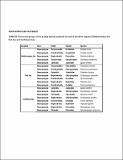Por favor, use este identificador para citar o enlazar a este item:
http://hdl.handle.net/10261/227486COMPARTIR / EXPORTAR:
 SHARE SHARE
 CORE
BASE CORE
BASE
|
|
| Visualizar otros formatos: MARC | Dublin Core | RDF | ORE | MODS | METS | DIDL | DATACITE | |

| Título: | In situ Pumping Rate of 20 Marine Demosponges is a Function of Osculum Area |
Autor: | Morganti, T. CSIC ORCID; Ribes, Marta CSIC ORCID ; Moskovich, Raz; Weisz, Jeremy; Yahel, G.; Coma, Rafael CSIC ORCID | Palabras clave: | Sponge (Porifera) Pumping rate Size Allometric scaling Osculum HMA-LMA sponges |
Fecha de publicación: | mar-2021 | Editor: | Frontiers Media | Citación: | Frontiers in Marine Science 8: 583188 (2021) | Resumen: | Sponges play a key role in the transfer of energy and nutrients into many benthic ecosystems, and the volume of water they process is an important regulator of these fluxes. Theoretical scaling relationships between sponge volume, osculum cross-sectional area, and pumping rates were recently proposed and confirmed for small sponge specimens in the lab. To examine how these relationships apply to field populations we measured, in situ, the pumping rate (PR) of 20 species representative of different morphologies and host types (high-and low-microbial abundance, HMA and LMA) from temperate and tropical regions. The total oscula area (∑OSA) increased allometrically with sponge volume (V) exhibiting similar exponents (∑OSA=aVb, b ranging 0.6-0.7) for all species, except for tropical HMAs (b= 0.99). Osculum flow rate (OFR) also increased allometrically with OSA and oscula of the same size pumped at the same rate irrespective of sponge volume. As a result, and in contrast to former reports, the PR of most of the sponges increased allometrically (PR=a∑OSAb) with scaling exponent b≈0.75, whereas PR of tropical HMAs increased isometrically. Osculum jet speed declined with the increase in the OSA for most species. The number of oscula and their OSA were the best predictors of the PR in sponges, explaining 75-94% of the in situ variation in PR throughout the natural range of sponge size. The pumping rate of a sponge population can be estimated by measuring the osculum density and cross-sectional area distribution once the relationships between the OSA and OFR are established for each species. | Descripción: | Corrigendum: In situ Pumping Rate of 20 Marine Demosponges Is a Function of Osculum Area by Morganti, T. M., Ribes, M., Moskovich, R., Weisz, J. B., Yahel, G., and Coma, R. (2021). Frontiers in Marine Science 8: 712856. doi: 10.3389/fmars.2021.712856 | Versión del editor: | https://doi.org/10.3389/fmars.2021.583188 | URI: | http://hdl.handle.net/10261/227486 | DOI: | 10.3389/fmars.2021.583188 | E-ISSN: | 2296-7745 |
| Aparece en las colecciones: | (CEAB) Artículos (ICM) Artículos |
Ficheros en este ítem:
| Fichero | Descripción | Tamaño | Formato | |
|---|---|---|---|---|
| Osculum_Area.pdf | Publisher's version | 15,96 MB | Adobe PDF |  Visualizar/Abrir |
| Morganti et al 2021 Manuscript Digital CSIC.pdf | Preprint | 889,59 kB | Adobe PDF |  Visualizar/Abrir |
| Morganti et al 2021 Supplementary DIGITAL CSIC.pdf | Preprint | 948,72 kB | Adobe PDF |  Visualizar/Abrir |
CORE Recommender
SCOPUSTM
Citations
13
checked on 24-abr-2024
WEB OF SCIENCETM
Citations
17
checked on 28-feb-2024
Page view(s)
273
checked on 27-abr-2024
Download(s)
269
checked on 27-abr-2024
Google ScholarTM
Check
Altmetric
Altmetric
Este item está licenciado bajo una Licencia Creative Commons

